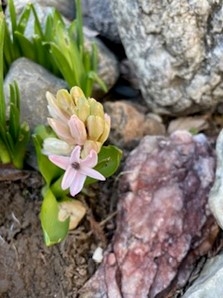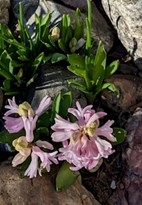As I walked through the garden yesterday, shooting out between the rocks was a pretty light pink flower I hadn't seen before. It was Hyacinthus orientalis, the herald of spring! This flowering perennial has many common names which include: Garden Hyacinth, Common Hyacinth or Dutch Hyacinth and resides in the Asparagaceae family. It is a native to Southwestern Asia, southern & central Turkey, Northwestern Syria, Lebanon, and Israel. It originated in the Eastern Mediterranean but is cultivated everywhere in the temperate world.[1] It was introduced to Europe in the 16th century but didn't became popular until the 18th century.
Common Hyacinth has many interesting characteristics beginning with its name. Hyacinth, in Greek mythology, was a man who was admired by both Apollo and Zephyr, but was killed in a jealous fight between the two Gods. From his blood emerged a flower that was named after him. Upon researching this plant, I discovered that it came in a myriad of colors from deep indigo, bright magenta, fuchsia, purple, white and light pink like the one in my garden pictured here that is just emerging.[2] (Note the rocks it is emerging from!) All the existing cultivars are derived from this species. This genus has three species of bulbous perennials that were found growing on rocky limestone slopes and cliffs 8,200ft up in Asia. They are cultivated for their loose to dense flowers. A standout characteristic of this beauty is its heady fragrance. This is why the plant is commonly grown for perfumes as well as its ornamental value due to the sheer beauty of the flowers they produce. When planted in full sun the plant reaches from 6” to 20” high and spreads from 2.5” to 4” wide. It produces fat spikes of bell-shaped flowers that grow from basil (at base) bundles of narrow bright green leaves. The semi-erect basal leaves are 6” to 14” long. They are strap-shaped, channeled, glossy, and dark green. They can be found growing in containers, beds, borders and in rock gardens as pictured in the two images above, showing the emerging flowers that grow as dense racemes.[3] The racemes[4] grow up to 8” long and are closely packed with tubular-bell-shaped single or double flowers, .75”-1.5” long. It is advised to plant the bulbs before the ground freezes. Plant in organically enriched, sandy well drained soil. For larger bulbs, plant 4”-5” apart and 5” deep. For smaller bulbs plant 3” deep, 4”-5” apart in the autumn. Be warned when handling, these bulbs have invisible barbs that can cause itching with some people, therefore it's always advisable to wash your hands before touching your face or eyes. If you plan to keep your bulbs in the ground fertilize as the blooms fade, removing the spent spikes and watering regularly until the foliage yellows. If you are planting in containers, use a porous mix of potting soil with the tip of the bulb near the surface. Cover this soil with a thick layer of mulch of sawdust, wood shavings or peat moss. This will help keep the bulbs cool, shaded, and moist until you start to see top growth. Once that happens remove the mulch and pace in full sun.[5]
Another approach is to force the bulb into early growth for indoor display in the winter. To do this plant them with the tips just showing in a container filled with soil based potting mix, making sure the container has drainage holes. Store in a dark place with a temperature range from above freezing to no higher than 45 degrees Fahrenheit for at least 10 weeks, allowing for root development. When the shoots reach 1” long, gradually increase both light and temperature. Remember “gradually” is the operative word! Water carefully. Avoid wetting the shoots or waterlogging your soil since both water logging and poor drainage lead to disease. Over-watering (not under watering) is the most common way people kill their plants. After the plant flowers it is safe to plant them in your garden where they will flower for years to come! Happy gardening!
[1] Wikipedia- Hyacinth orientalis
[2] FoliageFriend- What colors are Hyacinth Flowers? A simple guide to their vibrant spectrum
[3] A-Z Encyclopedia of Garden Plants- Hyacinthus pg
[4] A raceme is an unbranched, non-terminating type of inflorescence of stalks flowers growing on a single axis.
[5] Sunset Western Garden Book- pg 367-Hyacinthus orientalis

